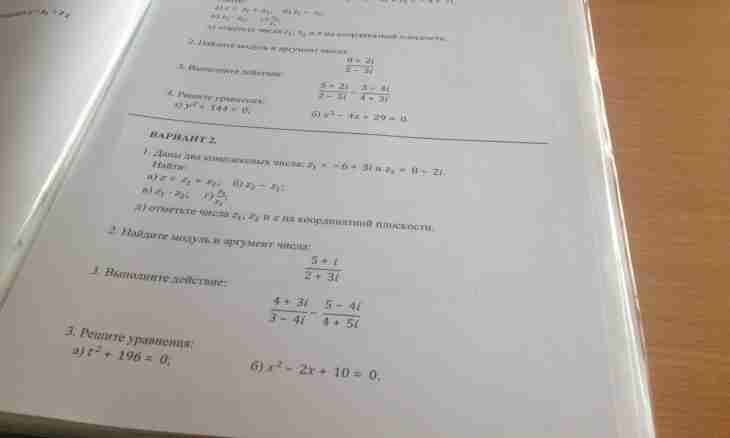Real numbers are not enough to solve any quadratic equation. The simplest of the quadratic equations which do not have roots among real numbers is x^2+1=0. At its decision it turns out that x=±sqrt(-1), and according to laws of elementary algebra, cannot take a root of even degree from a negative number.
It is required to you
- - paper;
- - handle.
Instruction
1. In this case there are two ways: the first – to follow the established bans and to consider that this equation of roots has no; the second – to expand the system of real numbers to such an extent that the equation will possess a root. So there was a concept of complex numbers of a look z=a+ib in which (i^2)=-1 where i – imaginary unit. Numbers an and b are called, respectively, the valid and imaginary parts of number of z Rez and Imz. An important role in actions with complex numbers is played by numbers complex interfaced. zs=a-ib, that is number having the opposite sign before imaginary unit is called interfaced to complex number of z=a+ib. So, if z=3+2i, then zs=3-2i. Any real number is a special case of complex number which imaginary part is equal to zero. 0+i0 - the complex number equal to zero.
2. Complex numbers can be put and multiplied the same as it is done with algebraic expressions. At the same time habitual laws of addition and multiplication remain in force. Let z1=a1+ib1, z2=a2+ib2.1. Addition and subtraction.z1+z2= (a1+a2) +i(b1+b2), z1-z2=(a1-a2)+i(b1-b2). 2. Multiplication.z1*z2= (a1+ib1) (a2+ib2) =a1a2+ia1b2+ia2b1+(i^2) b1b2=(a1a2-b1b2)+i(a1b2+a2b1). At multiplication just remove the brackets and apply definition of i^2=-1. The work of the complex interfaced numbers is a real number: z*zs=(a+ib) (a-ib) == a^2-(i^2) (b^2) = a^2+b^2.
3. 3. Division. To lead private z1/z2=(a1+ib1)/(a2+ib2) to a standard look it is necessary to get rid of imaginary unit in a denominator. It is the for this purpose simplest to increase numerator and a denominator by the number interfaced to a denominator: ((a1+ib1) (a2-ib2)) / ((a2+ib2) (a2-ib2))= (a1a2+b1b2) of +i(a2b1-a1b2)) / (a^2+b^2) = = (a1a2+b1b2)/(a^2+b^2) of +i(a2b1-a1b2) / (a^2+b^2). Operations of addition and subtraction and also multiplication and division are the mutually return.
4. Example. To find (1-3rd) (4+i) / (2-2nd)= (4-12i+i+3) (2+2i) / ((2-2nd) (2+2i))= (7-11th) (2+2i) / (4+4)= (14+22)/8+i (-22+14)/8=9/2-irassmotrite geometrical interpretation of complex numbers. For this purpose with the rectangular Cartesian system of coordinates 0xy each complex number of z=a+ib needs to put to the plane in compliance the plane end with coordinates of an and b (see fig. 1). The plane on which such compliance is realized is called the complex plane. On axis 0x real numbers are located therefore it is called the valid axis. On axis 0y imaginary numbers are located, it carries the name of an imaginary axis.
5. Radius vector of this point is connected with each point of z of the complex plane. Length radius vector, representing complex number z, is called modulemr= |z| of complex number; and the corner, between the positive direction of the valid axis and the direction of a vector 0Z, is called an argument of argz of this complex number.
6. The argument of complex number is considered positive if it is counted from the positive direction of axis 0x counterclockwise, and negative at an opposite direction. To one complex number there corresponds the set of values of an argument of argz+2pk. From these values the argz values lying ranging from – p to the item are considered as main. The interfaced complex numbers z and zs have equal modules, and their arguments are equal on an absolute value, but differ in the sign.
7. Thus, |z| ^2=a^2+b^2, |z| =sqrt(a^2+b^2). So, if z=3-5i, then |z| =sqrt (9+25)=6. Besides, as z*zs= |z| ^2=a^2+b^2, becomes possible calculation of modules of the whole complex expressions in which imaginary unit can repeatedly appear. As z= (1-3) (4+i) / (2-2) =9/2-i, direct calculation of module z will give |z| ^2=81/4+1=85/4 and |z| =sqrt (85)/2. Passing a calculation stage expression, considering that zs=(1+3i) (4-i)/(2+2i), it is possible to write down: |z| ^2=z*zs == (1-3rd) (1+3i) (4+i) (4-i) / ((2-2nd) (2+2i))= (1+9)(16+1)/(4+4)=85/4 and |z| =sqrt (85)/2.

